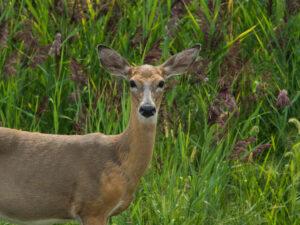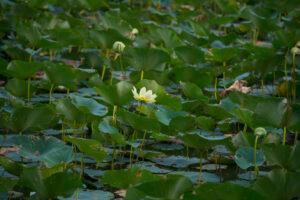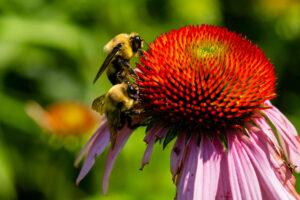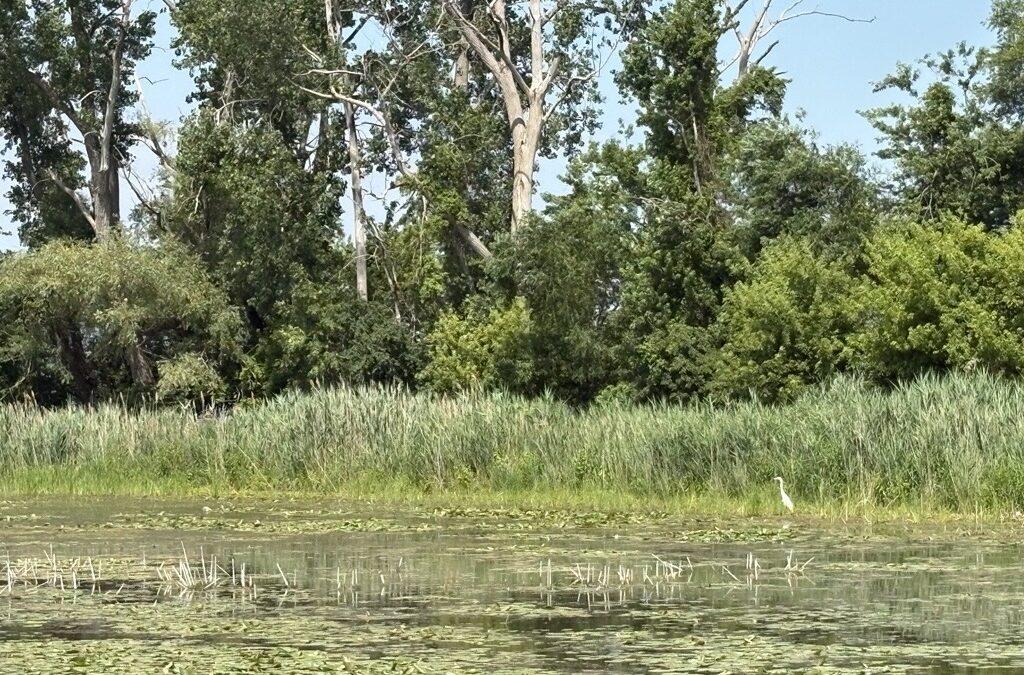As one of Michigan’s largest landowners, DTE Energy takes land management seriously. Generating power for millions takes a lot of space and caring for that space is top priority for the company’s environmental team, who oversees dozens of wildlife habitats across DTE properties around the state.
The team manages more than 2,000 acres of habitat including wetlands, prairies, pollinator gardens and more. These habitats support a variety of animals from reptiles and rodents to eagles and coyotes and DTE’s experts strive to make sure they have what they need to thrive.

A deer at a DTE Energy wildlife habitat.
“It’s important for us to provide wildlife habitats like this because of the areas in southeastern Michigan that we occupy,” said Jacob Maas, senior environmental engineer who helps manage the habitat at the Fermi 2 Power Plant. “We’re in a very biodiverse area that has the potential for many native species to flourish, and we take great pride in restoring native areas to their native landscapes so they can thrive and prosper.”
The habitat at Fermi covers more than 1,200 acres and includes wetlands, prairie and even a quarry, supporting osprey, turtles, fish and even a resident beaver. DTE partnered with the International Wildlife Refuge to preserve more than 100 acres at the site to provide the animals the support they need.
It’s been a win/win for the wildlife and for the staff at Fermi.
“We have taken all the necessary steps to encourage positive relationships between those working on site, as well as the wildlife that are here, and so that we can enjoy them safely and comfortably from both sides,” said Maas.
A few miles south, the Monroe Power Plant provides hundreds of acres for protected species like bald eagles, monarch butterflies and even the American Lotus, which grows in the waters near the plant.
“We’re one of the largest companies in the state. With that comes the responsibility of making sure that the work we do doesn’t negatively impact the environment,” said Chris Paquette, an environmental supervisor who supports the Monroe wildlife habitat. “DTE taking a strong stance on being a positive environmental steward and being a good role model for the rest of Michigan.”

American Lotus at the Monroe Power Plant.
The hundreds of acres at the Monroe plant offer so much to so many animals, what the team sees on site can change a lot from season to season.
“My favorite part of being here at Monroe is to see all the wildlife throughout the year,” said Paquette. “In the winter, we have hundreds of bald eagles that show up on site. And in the spring, we have a nesting pair of peregrine falcons.”
While larger habitats like the ones at Fermi and the Monroe Power Plant have a big impact, so do smaller scale sites like pollinator gardens and a native beach grass area the Muskegon Service Center partnered with Mona Shores Middle School to install years ago.
“We wanted to create a really quality environment for our pollinators, especially ones who are at risk,” said Ivana Liikala, a technical analyst in Muskegon. “And we provided an outdoor classroom for our students to learn about different species, different plants, and how they pollinate.”
For the site at Mona Shores, it was especially satisfying for the team to help share the knowledge and the work of caring for the environment beyond just DTE.

A bee in a pollinator garden.
“It’s really cool working hand-in-hand with our local schools, with our local churches and just our community in general,” said Ivana. “We’re providing the education that they need and the resources that they need to let them know we care about having a safe environment.”
When planting, the environmental team is careful to select plants that are either native to the area or are non-invasive, offering the support this wildlife needs to not just survive but thrive in our ever-changing world. Pollinators are a particular focus of these plantings, with bees, birds, butterflies and even bats kept in mind when deciding what is planted at locations like Warren Service Center.
Once an industrial site, the environmental team has reclaimed the half-acre of land with flowering plants and grasses to support pollinators, as well as installing bird and bat houses.
“We’ve worked very diligently to promote this wildlife habitat,” said Jerry Chilson, an environmental engineer who supports the Warren site. “There’s a variety of plants and animals here and it’s really exciting. I’ve seen a lot of redwing blackbirds and small, finch like birds; there’s butterflies, bees, many other bugs. We even have different rodents.”
For the dedicated environmental team, the work is central to their mission, but it’s also work they’re passionate about continuing as DTE helps native plants and wildlife thrive across its service territory.
“I’m grateful for the opportunity through DTE to work on these habitat projects,” said Jerry. “It’s something different from the normal, everyday operations. The team has been working hard on this and you see what we’ve come up with here. It’s the fruit of our labor.”
